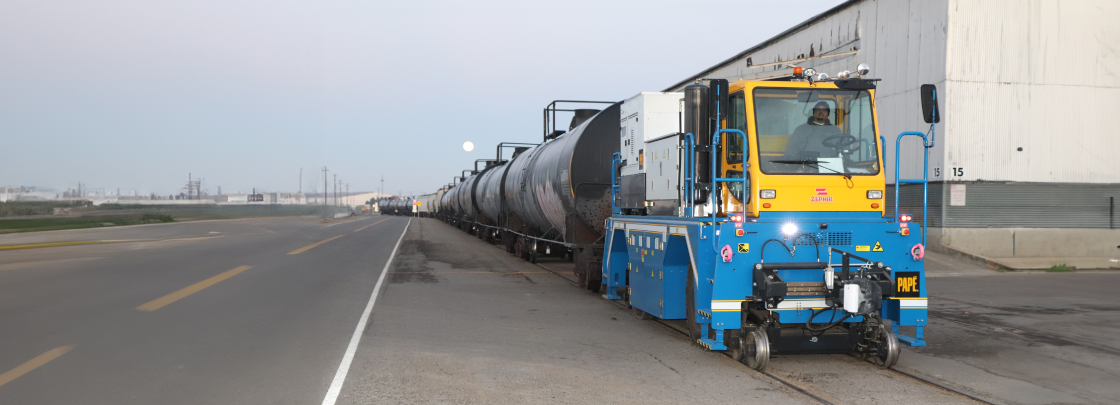Transforming freight in Australia through rail sustainability initiatives
As the world pivots towards a greener future, the Australian government has committed to achieving a number of environmental, social, and governance (ESG) goals for 2030 and 2050; however, it cannot do so without businesses also reducing their carbon emissions.1
In June 2023, the Department of the Treasury announced its intent to legislate mandatory climate and emissions reporting from 1 July 2024.2 As part of its contribution, Australia’s rail sector is embracing more eco-friendly freight practices and sustainable initiatives. Rail plays a pivotal role in supply chains across different sectors, making this is an ideal opportunity for the freight rail industry to commit to lower emissions, supporting Australian industries and businesses as they transition towards a more sustainable, low carbon economy.

How businesses can reduce carbon footprints with rail transportation
For shippers, logistics professionals, and businesses eager to reduce their carbon footprint, understanding the role of ESG commitments in rail transportation is crucial.
For example, in its inaugural 2022 Environmental, Social, and Governance (ESG) Report, the Australian Rail Track Corporation (ARTC) stated that its ESG ambition is to support a modal shift to rail for a sustainable future. This aligns with the ARTC’s stated purpose ‘to improve Australia’s productivity by making rail the mode of choice in the national logistics chain.’ This can be seen in ARTC’s Inland Rail project, which, once operational, is predicted to reduce carbon emissions by 750,000 tonnes per year by 2050. This is the equivalent of the annual emissions from 40,000 Australian households.3
Rail transport is inherently more energy-efficient than road transport. However, the push to further reduce emissions in rail freight by integrating cutting-edge technologies and renewing infrastructure to make it more energy efficient is gaining momentum in Australia.
Let’s look at some of these rail sustainability initiatives—both current and future-focused—and how they can support the ESG goals of any industries that rely on supply chains and logistics.
- Electrification and renewable energy
A significant step in this direction is the electrification of rail lines, powered increasingly by renewable energy sources. This shift both decreases the reliance on fossil fuels and substantially reduces greenhouse gas emissions. Solar and wind energy are becoming the backbone of this transformative journey.4 However, there are many steps businesses can take today to reduce their emissions in the interim, until this shift is complete.
Freightquip Australia is a Zephir agent for the Oceania region, the European leader in railroad shunting equipment. Zephir is ahead of the curve, offering a range of large and light electric shunt vehicles that are fully electric with no emissions. We believe that we will see more electric versions of traditional equipment entering the market and will continue to partner with international leaders in the field to ensure these are available to the Australian market.
- Sustainable infrastructure programs
Infrastructure is at the heart of rail sustainability initiatives. Sustainable infrastructure programs can focus on several key areas, such as enhancing existing rail networks for better efficiency and lower energy consumption. This includes investments in better signalling systems, track upgrades, and more efficient freight terminals.
Adopting smart technology like artificial intelligence (AI) and Internet of Things (IoT) for predictive maintenance and optimised operations is also an important step that helps to reduce resource wastage and improve efficiency. Additionally, making an increasingly conscious effort to use sustainable materials from construction to maintenance will reduce the overall environmental impact of infrastructure over its lifecycle.
- Empowering a circular economy in the rail industry
Establishing a circular economy also plays a critical role in overall sustainability. In rail freight, this can involve several strategies. For example, rail components, including metals and composites, can be recycled and reused to reduce waste and conserve natural resources. Additionally, technologies that facilitate the regeneration and reuse of energy, especially in electric trains, should be explored. For example, energy generated during braking can be stored and reused. Hybrid locomotives already use regenerative braking systems that convert kinetic energy back into electricity to be stored when braking.5
Focusing on a sustainable future
As the rail industry tracks its path towards a more sustainable future, the integration of ESG criteria into business models is more than an advantage; it’s imperative. The Australian rail industry is ideally positioned to seize this opportunity to reshape operations, promote new partnerships, and innovate in green services. This will contribute to a greener planet and secure the industry’s position in a rapidly evolving, sustainability-driven market.
